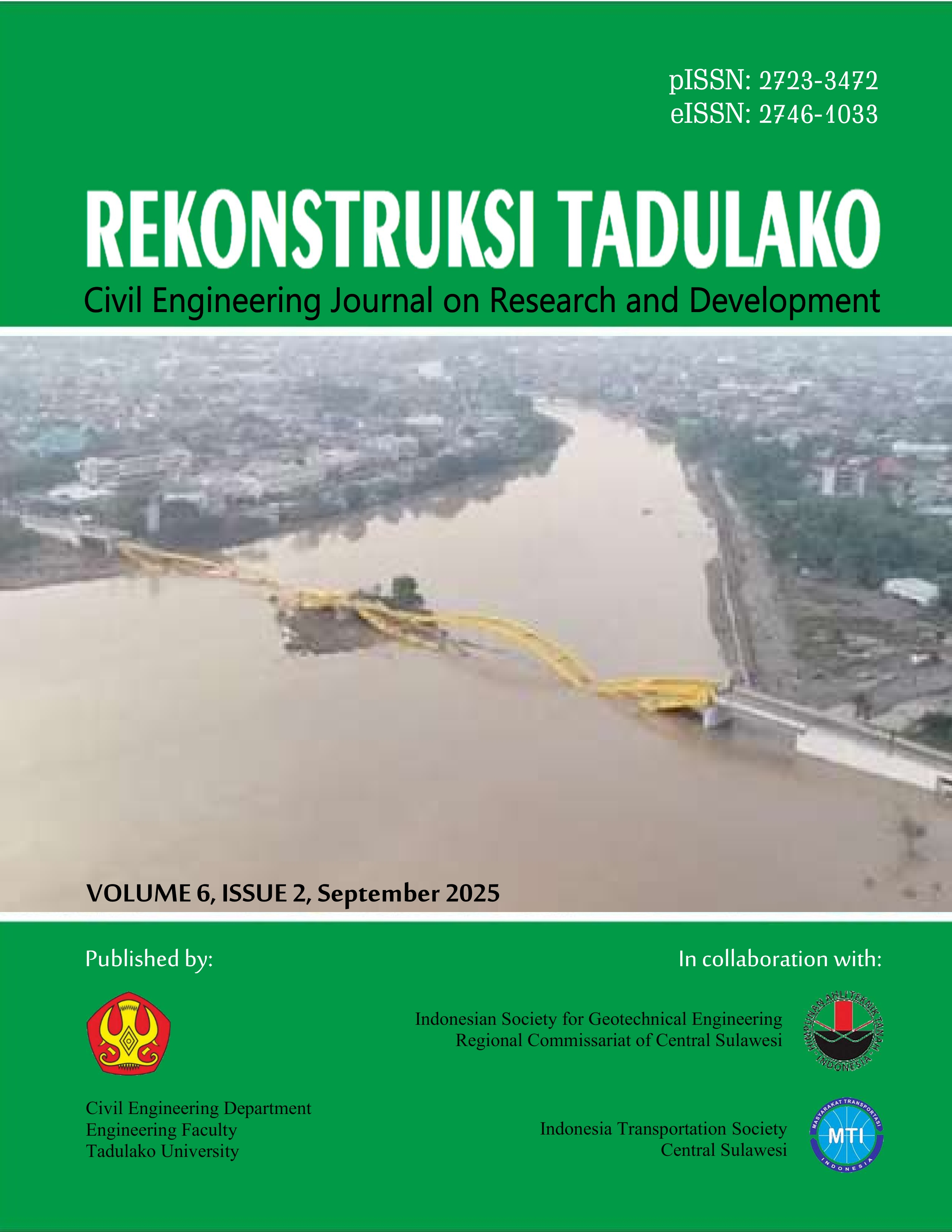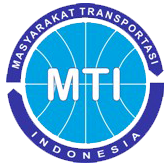Analisis Transpor Sedimen Dasar Sungai Alopohu yang Bermuara di Danau Limboto
DOI:
https://doi.org/10.22487/renstra.v6i2.708Keywords:
sedimentation, Alopohu river, Meyer-Peter and Muller, Einstein, FrijlinkAbstract
One of the causes of flooding in Gorontalo is the reduced capacity of Lake Limboto, which has served as a natural water reservoir and flood preventer, to perform these functions effectively due to siltation. This diminished capacity is attributable to the deposition of sedimentary material carried by the rivers that drain into Lake Limboto. A total of 23 rivers discharge into Lake Limboto, contributing sedimentation on an annual basis. Among these, the Alopohu River is one of the most significant contributors. The objective of this study was to quantify the sediment transport generated by the Alopohu River. The analysis was conducted through the collection of direct measurement observation data in the downstream region of the Alopohu River, with the objective of obtaining data on river geometry, flow velocity, instantaneous discharge, and bottom sediment samples. Laboratory tests were conducted on basic sediment samples in order to ascertain the characteristics of the sediment grains. The data were subsequently analyzed using empirical formulas, namely the Meyer-Peter and Muller, Einstein, and Frijlink formulas. The quantity of bed sediment transport (bed load) in the downstream Alopohu River, as determined by discharge measurements and the application of the Meyer-Peter and Muller formula, is 2.86 tons per year. The Einstein formula yields a value of 621 tons per year, while the Frijlink formula produces a result of 54.67 tons per year. The discrepancy in the calculated values for each empirical formula is attributed to the specific parameters utilized in each formula
Downloads
References
S.L Mahmud, N. Achmad, and H.S. Panigoro, "Revitalisasi Danau Limboto dengan Pengerukan Endapan di Danau: Pemodelan, Analisis, dan Simulasinya", Jambura Jurnal Biomath, vol. 1, no. 1, p. 31, 2020.
I. Umar, A. Marsoyo, and B. Setiawan,"Analisis Perubahan Penggunaan Lahan Sekitar Danau Limboto di Kabupaten Gorontalo", Tata Kota dan Daerah, vol. 10, no. 2, p. 77, 2018.
I.S. Yudha, "Detection of Changes in Water Surface Area in Limboto Lake Using Landsat Data From 1990 to 2020", IOP Publishing, vol. 2023, p.1, 2023.
A. Suwanto, T.N. Harahap, H. Manurung, W.C. Rustadi, S.R. Nasution, and I.N.N, Suryadiputra, Profil 15 Danau Prioritas Nasional, Jakarta: Kementrian Lingkungan Hidup, 2011.
S. Karim, P.J.C. Franklin, and J.A.R. Sondakh, " Utilization of Land Around Lake Limboto, Gorontalo Regency", Jurnal Spasial, vol. 9, no. 1, p. 124, 2022.
D.H. Mano, Pendangkalan Danau Limboto 46,6 Cm Per Tahun, Gorontalo: BLHRD, 2016.
M. Jahja, Y.I. Arifin, N.A. Gafur, F. Masulili, A.P.M., Kusuma, and M. Sakakibara, "Performances of Erosion Control Blanket Made From Palm Fiber On Reducing Erosion in the Slopes of Lake Limboto Basin", E3S Web Conference, vol. 400, p. 1, 2023.
M.A. Rahman, U. Lasminto, B. Sarwono, and Edijatno, "Studi Pengaruh kapasitas Tampung Danau Limboto terhadap aliran sungai Limboto Gorontalo", Prosiding Seminar Nasional Teknik Sipil XI, p. 1, 2015.
A. Alfianto, .Cecilia S, and B. Ridwan, "Pemodelan Potensi Erosi dan Sedimentasi Hulu Danau Limboto dengan WATEM/SEDEM", Jurnal Teknik Hidraulik, vol. 11, no. 2, p. 67, 2020.
F. Lihawa, Daerah Aliran Sungai Alo, Yogyakarta: Deepublish, 2017.
Y. Mosi, N. Warow, M. Usman, I.C. Bahuwa, N. Rosalia, and Z.S. Kadir, "Analisis Erosi dan Sedimentasi di Sub Das Alo-Pohu Kesatuan Pengelolaan Hutan Vi Gorontalo", Jurnal Sains, Teknologi dan Lingkungan, vol. 10, no. 2, p. 321, 2024.
R. Haluti, U. Andawayanti, and H. Siswoyo, "Effectiveness Analysis of Sediment Control Building in the Alopohu River Flow", IrjaesCom, vol. 7, no. 3, p. 234, 2022.
A. Kuruqi, G. Kocileri, and M. Ardiclioglu, "Potential of Meyer-Peter and Müller Approach for Estimation of Bed-Load Sediment Transport under Different Hydraulic Regimes", Modeling Earth and System Environment, vol. 6, no. 1, p. 129, 2020.
S.J. Benavides, E. Deal, M. Rushlow, V.G. Venditti, Q. Zhang, and K. Kamrin, "The Impact of Intermittency on Bed Load Sediment Transport", Geophysic Research Letter, vol. 49, no. 5, p. 1, 2022.
Nenny, "Karakteristik Sedimen dan Pola Transportasi di Sungai Berdasarkan Variasi Debit Aliran", Journal of Innovation Research and Knowledge, vol. 4, no. 1, p. 53, 2024.
M. Maqdan, E. Yogafanny, A. Sungkowo, M.A. Setiawan, and J. Sartohadi, "Analisis Karakteristik Sedimen Melayang dan Sedimen Dasar pada Sungai Bompon untuk Pengelolaan DAS Terpadu di Sub DAS Bompon, Kabupaten Magelang, Jawa Tengah", Jurnal Mineral, Energi, dan Lingkungan, vol. 3, no. 1, p. 26, 2019.
Saiffuridzal, E. Hidayah, G. Halik, W.Y. Widiarti, and S.I.L. Prasojo, "Pengukuran Debit di Saluran Irigasi (Studi Lokasi Daerah Irigasi Kabupaten Jember)", PEKAT Jurnal Pengabdian Kepada Masyarakat, vol. 2, no. 2, p. 59, 2023.
D. Weg, W. Van, and G.A.D. Tel, Coastal Sediment Transport, Newyork: Willey and Son, 1976.
W.R. White, H. Milli, A.D. Crabbe, "Sediment Transport: An Appraisal of Available Methods", Journal of Water, vol. 1, p. 1., 1973.
Downloads
Published
How to Cite
Issue
Section
License
Copyright (c) 2025 REKONSTRUKSI TADULAKO: Civil Engineering Journal on Research and Development

This work is licensed under a Creative Commons Attribution 4.0 International License.







 This work is licensed under a
This work is licensed under a 


